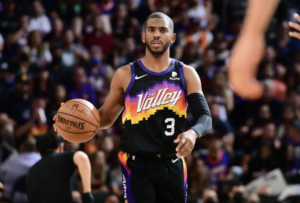Ranking of NBA’s players deadliest midrange assassins
As the analytics community increases, one of the most popular discussions in basketball is the role of the mid-range jump shot in the current NBA.
While such arguments are getting old, the statistics suggest that the league is shifting away from the mid-range game. At the same time, the mid-range game isn’t going away anytime soon, thanks to the style of play of some league players.
We searched three parameters to identify which players are working with the most difficulty to keep the mid-range game alive in the NBA. We evaluated how each individual fared relative to the league average over the same period (going back to 2018-19):
-
Output: To assess someone’s mid-range prowess, we calculated total field goals created outside four feet but inside the three-point line per 100 possessions.
-
Shot dependency: We looked at how frequently a player’s shots came from anywhere on the floor other than the hoop and beyond the arc.
-
Efficiency: This is the percentage of field goals a player made on short and long mid-range attempts.
Former NBA players who have just retired (e.g., Shaun Livingston, Tony Parker, and LaMarcus Aldridge) would have likely made this record if they were still active and had not yet retired.
The players listed below are putting in the most effort to keep the NBA’s “in-between” division alive in their absence.
DeMar DeRozan
-
Output (FGM per 100 poss.): 7.2
-
Shot Dependency (frequency): 69.5%
-
Efficiency (FG%): 45.3%
DeMar DeRozan will be at the top of any list of contemporary mid-range shooters, as you already know. DeRozan would continue to play the in-between game even if everyone else in the NBA only shot at the rim or from beyond the arc. DeRozan didn’t have access to cable television while growing up in Los Angeles. He previously said that because the Los Angeles Lakers were the only televised team, he watched a lot of Kobe Bryant. Bryant was a master of the mid-range shot in his own right, and DeRozan has developed into the same player during his time in the NBA. It has motivated his seven consecutive seasons of averaging at least 20.0 points each game. He has statistically relied on these looks more than any other NBA player.
But it’s also worked because, according to Cleaning the Glass, his mid-range jumper in the last five seasons has been between ten and thirty percentage points better than his long-range shots. Given its gorgeous appearance, it’s difficult to criticize him for wanting to take it as frequently as he does.
But as Jonathan Tjarks pointed out, DeRozan’s growth to eventually step beyond the arc more frequently was unavoidable so he could act as a greater floor spacer (via The Ringer):
“DeRozan’s inability to make 3-pointers in the past was never due to any mechanical issue. Once a slasher who relied heavily on his athleticism, he entered the NBA but has since developed into a skilled scorer with the touch and footwork to knock down mid-range jumpers. His increased readiness to take catch-and-shoot 3-pointers is more of a sign that he is settling into a new role.
DeRozan was the focal point of a deal that took him to the Western Conference to play for the San Antonio Spurs after spending most of his career with the Toronto Raptors. DeRozan, though, will return to the East and join the Chicago Bulls’ starting frontcourt for the upcoming year.
Defenders must focus on their two-man game because Zach LaVine and Nikola Vucevic are adept at the pick-and-roll. The defense won’t be able to overlook Patrick Williams, a second-year forward who performed well after being given control of Chicago’s attack during summer league.
So, DeRozan might get a lot of open shots from the mid-range, and if we are familiar with him, he will take them. Yet his playmaking has also been called better, as PBP Stats shows no one has helped on more deep mid-range jumpers since 2018–19. You shouldn’t be shocked if his teammates begin taking more mid-range shots.
Kevin Durant
-
Output (FGM per 100 poss.): 6.6
-
Shot Dependency (frequency): 51.7%
-
Efficiency (FG%): 52.5%
For a few moments, you may observe Kevin Durant’s shot chart and realize that he shoots brilliantly from every area of the court. Yet, the mid-range is one region that excels. Durant joined the conversation on Twitter regarding mid-range shots during the 2019 summer as he was recovering from a torn Achilles. Durant delivered a memorable one-liner about using graphs in athletics in a classic Twitter performance. The entire exchange offered a fascinating look into the thoughts of one of the greatest shooters in history. Durant suggested in this chat that the mid-range look might only sometimes be the best option. He pondered why he would give up the simple search for something contentious.
According to Durant, a guarded opportunity should never be passed up to force a less certain opportunity at the rim or the three-point line.
What’s crazy, though, is that throughout his previous eight seasons, an unbelievably high % of his mid-range attempts have been challenged, according to ESPN’s Kirk Goldsberry. Durant has remained the league’s most productive player from this zone since 2013–14.
He also produced admirably, averaging 2.9 pull-up two-pointers per game last year, just behind teammate Kyrie Irving’s 3.0, which topped the Eastern Conference.
But, once the playoffs started, Durant’s performance faltered, and he began to lead the league in pull-up two-pointers, averaging 5.3 per game, nearly one more than any other player.
In the end, Durant thinks that athletes are best at what they practice the most, and if they don’t work on their mid-range game, they won’t know how excellent they can be. He has, however, been playing the game long enough to be aware of the times when it feels like his stroke is sinking exceptionally well.
He said, “If my mommy works, that’s where I’m going for dinner.”
Chris Paul
-
Output (FGM per 100 poss.): 5.5
-
Shot Dependency (frequency): 54.7%
-
Efficiency (FG%): 51.2%
Chris Paul, a point guard for the Phoenix Suns, had one of his best seasons despite his old age. His mid-range jumper was one of his primary methods for achieving this. Paul had one of any player’s most productive mid-range seasons during the previous 25 years. One of the reasons Devin Booker and Deandre Ayton made such significant advancements in 2020–21 was his ability to create off the dribble, which relieved some of the burdens the two young stars were under before he arrived in Phoenix.
During his entire career, including eleven trips to the All-Star game, the most crucial component of Paul’s shot repertoire is his right elbow pull-up jumper.
Yet, there is more room to use ball screens from the mid-range because defenders are now concentrating more on guarding the rim and the perimeter.
When opponents increasingly learn to drop coverage near the basket, Paul might dribble off the pick and kick out to a shooter on the outside or take the long two. He actually averaged more two-point shots from the pull-up this past season than any other player in the NBA.
He made eight consecutive mid-range shots in less than ten minutes against the Denver Nuggets, proving it was influential in the postseason. As the Suns attempt to retain their title as conference champs, look on Paul to continue providing Phoenix an advantage every time he takes on the court. His defenders are undoubtedly still having nightmares about the hot run.
According to PBP Stats, he also helped out on 162 mid-range connections to his teammates, second only to Russell Westbrook in the NBA. After taking that into account, he might have the title of the real king of the in-between game.
Nikola Jokic
-
Output (FGM per 100 poss.): 5.8
-
Shot Dependency (frequency): 46.1%
-
Efficiency (FG%): 45.3%
When discussing the current league MVP, fans frequently focus on Nikola Jokic’s playmaking. When a 7-footer consistently records triple-doubles, which he does, it’s simple to measure success. Yet his shooting is equally as spectacular as his passing. The incredible two-man game that Jokic and Jamal Murray have developed over the previous several seasons, which the guard’s injury will prevent him from playing in for the majority of next season, has undoubtedly helped the Nuggets reach amazing heights. The two made a great team in a pick-and-roll offense, with Jokic establishing a screen before bursting out for a jump shot off the catch, usually near the free-throw line.
What’s more intriguing, though, is that Jokic and Murray also displayed a variety of exciting moves, including some captivating 5-1 PnR sets and cunning dribble-handoff movements.
Denver, for instance, might employ a novel inverted ball screen with Jokic as the ball handler. Alternately, he might maintain the ball and fake the dribble handoff to open up opportunities for himself from mid-range. He occasionally even makes a jump shot while in motion following an off-ball screen, just for good measure and to demonstrate his versatility.
Jokic is one of the league’s most deadly threats to take a hook jumper from the elbow or drop step after a post-up. Nobody in the NBA has been more productive or effective from the short mid-range during the previous few seasons except Robin Lopez.
Nevertheless, his invention, the Sombor Shuffle, has proven to be his strongest attack. His go-to move for late-game heroics and game-winners is this one. Whenever it is brought up, it is often compared to Dirk Nowitzki’s famous mid-range stepback.
The Sombor Shuffle is when a player faces up their opponent on the block, fakes a drive with their left foot, then quickly takes a one-dribble fadeaway jumper with their right foot. He claimed that to avoid applying pressure to his hurt left foot; he began using it when recovering from an injury. You can tell how annoyed Draymond Green, a former defensive player of the year, was by the shot.
His enormous size, incredible footwork, and extremely high jumper release point make his mid-range shot a tough one to defend. Only human cannonball Zion Williamson made more two-pointers this past season while his defenders were within two to four feet of him.
That means that even if the opposition decides to double-team Jokic, he can find an open teammate for a simple layup. He is the MVP as a result of that.
Kawhi Leonard
-
Output (FGM per 100 poss.): 6.2
-
Shot Dependency (frequency): 49.3%
-
Efficiency (FG%): 46.1%
LeBron James is the NBA player most frequently compared to Michael Jordan and Kobe Bryant, but the Los Angeles Lakers great isn’t like any of them. On the other hand, Leonard resembles Jordan and Bryant far more than he does, at least in their favored offensive strategies. These comparisons are fair when they are made. In actuality, Bryant served as Leonard’s “mechanical model” as he developed his style of play during his formative years with the Spurs. Leonard had the chance to work out with the five-time NBA champion and referred to the late Bryant as one of his mentors.
Because of this, Clippers coach Ty Lue permits Leonard to shoot from mid-range as much as he sees appropriate (per ESPN):
“I believe it to be a lost art. Let’s focus on what other teams are sacrificing. Every team likes to concede the mid-range shot, the mid-range 2, so why not keep working on the shots the squad is giving up? As you can see, even in crucial fourth-quarter circumstances, the mid-range shots decide the outcome of the games. You’ll receive shots like that during the playoffs as well.
Lue is correct, given that Leonard was unstoppable from mid-range during postseason action.
He was shooting 67.7 percent of the shots he took between the free-throw line and the three-point line, according to Cleaning the Glass, despite the relatively small sample size. Basketball-Reference reports that the league’s average field goal percentage this past season was 67.5 percent from 0 to 3 feet from the hoop.
Clint Parks, his skills coach, explained to Clutch Points that a mid-range shot “is a layup for Leonard.”
HONORABLE MENTIONS
In addition, the following players are still taking mid-range shots:
-
CJ McCollum (Portland)
-
Dejounte Murray (San Antonio)
-
Derrick Rose (New York)
-
Devin Booker (Phoenix)
-
Joel Embiid (Philadelphia)
-
Jonas Valanciunas (New Orleans)
-
Khris Middleton (Milwaukee)
-
Kyrie Irving (Brooklyn)
-
Nikola Vucevic (Chicago)
-
Robin Lopez (Washington)
-
Serge Ibaka (L.A. Clippers)
-
T.J. McConnell (Indiana)
NBA column by mark
- Magic Johnson Success story January 24, 2024
- Michael Jordan success story January 24, 2024
- Greatest NBA Trios of All Time October 14, 2021
- Which NBA team has won the most championships? October 11, 2021
- NBA 2021/22 – Eastern Conference winner October 4, 2021
- NBA 2021/2022 DPOY Prediction? October 4, 2021
- Who is the top 10 centers of all time? October 4, 2021
- Top 10 small forwards of all time October 4, 2021
- Top 10 NBA shooting guards of all time October 4, 2021
- NBA rookie of the year 2022 September 29, 2021






